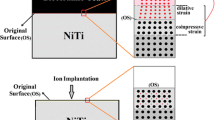Abstract
Localized oxidation and corrosion behavior of a nickel–titanium (NiTi) shape memory alloy (SMA) was investigated via static immersion experiments in a simulated body fluid solution. Detailed electron microscopy examinations on the sample surfaces revealed preferential formation of local oxide particles around dislocation networks, which constitute high-energy zones. Moreover, various intermediate phases were detected in addition to the parent NiTi phase around dislocation networks. These are also areas with enhanced diffusion, which promotes Ni release. These findings emphasize the significant role of fine microstructural features, such as dislocation networks, on the oxidation and Ni release, and thus, the biocompatibility of the NiTi SMAs.







Similar content being viewed by others
References
Mantovani D (2000) Shape memory alloys: properties and biomedical applications. JOM 52:36–44
Duerig T, Pelton A, Stöckel D (1999) An overview of nitinol medical applications. Mater Sci Eng A 273:149–160
Otsuka K, Ren X (1999) Recent developments in the research of shape memory alloys. Intermetallics 7:511–528
Mani G, Feldman MD, Patel D, Agrawal CM (2007) Coronary stents: a materials perspective. Biomaterials 28:1689–1710
Bansiddhi A, Sargeant TD, Stupp SI, Dunand DC (2008) Porous NiTi for bone implants: a review. Acta Biomater 4:773–782
Nikolai RJ (1997) Orthodontic wire: a continuing evolution. Semin Orthod 3:157–165
Toker SM, Canadinc D, Maier HJ, Birer O (2014) Evaluation of passive oxide layer formation–biocompatibility relationship in NiTi shape memory alloys: geometry and body location dependency. Mater Sci Eng C 36:118–129
Huang HH, Chiu YH, Lee TH, Wu SC, Yang HW, Su KH, Hsu CC (2003) Ion release from NiTi orthodontic wires in artificial saliva with various acidities. Biomaterials 24:3585–3592
Shabalovskaya SA, Tian H, Anderegg JW, Schryvers DU, Carroll WU, Humbeeck JV (2009) The influence of surface oxides on the distribution and release of nickel from Nitinol wires. Biomaterials 30:468–477
Rondelli G (1996) Corrosion resistance tests on NiTi shape memory alloy. Biomaterials 17:2003–2008
Sun XT, Kang ZX, Zhang XL, Jiang HJ, Guan RF, Zhang XP (2011) A comparative study on the corrosion behavior of porous and dense NiTi shape memory alloys in NaCl solution. Electrochim Acta 56:6389–6396
Li YH, Rao GB, Rong LJ, Li YY (2002) The influence of porosity on corrosion characteristics of porous NiTi alloy in simulated body fluid. Mater Lett 57:448–451
Hanawa T (1999) In vivo metallic biomaterials and surface modification. Mater Sci Eng A 267:260–266
Hanawa T (2004) Metal ion release from metal implants. Mater Sci Eng C 24:745–752
Tian H, Schryvers D, Liu D, Jiang Q, Humbeeck JV (2011) Stability of Ni in nitinol oxide surfaces. Acta Biomater 7:892–899
Vojtech D, Voderova MJ, Novak P, Kubasek T (2010) Surface structure and corrosion resistance of short-time heat-treated NiTi shape memory alloy. Appl Surf Sci 257:1573–1582
Wong MH, Cheng FT, Pang GKH, Man HC (2007) Characterization of oxide film formed on NiTi by laser oxidation. Mater Sci Eng A 448:97–103
Wong MH, Cheng FT, Man HC (2008) Comparison of corrosion resistance and apatite-forming ability of NiTi treated by different low-temperature methods. J Alloys Comp 466:L5–L10
Cheng FT, Shi P, Pang GKH, Wong MH, Man HC (2007) Microstructural characterization of oxide film formed on NiTi by anodization in acetic acid. J Alloys Comp 438:238–242
Tan L, Crone WC (2002) Surface characterization of NiTi modified by plasma source ion implantation. Acta Mater 50:4449–4460
Sullivan SJL, Dreher ML, Zheng J, Chen L, Miyashiro Madamba D, Trépanier KC, Nagaraja S (2015) Effects of oxide layer composition and radial compression on nickel release in nitinol stents. Shap Mem Superelast 1:319–327
Oshida Y (2007) Bioscience and bioengineering of titanium materials, 1st edn. Elsevier, Great Britain
Hou J, Peng QJ, Shoji T, Wang JQ, Han EH, Ke W (2011) Effects of cold working path on strain concentration, grain boundary microstructure and stress corrosion cracking in Alloy 600. Corros Sci 53:2956–2962
Standard X-ray Diffraction Powder Patterns: Section 18. Data for 58 Substances Page: 54 retrieved from: https://digital.library.unt.edu/ark:/67531/metadc13210/m1/60/
Dewalsky MV, Jeitschko W, Wortmann U (1991) The metallic Polyphosphide Ti2NiP5. Chem Mater 3:315–319
Author information
Authors and Affiliations
Corresponding author
Ethics declarations
Conflict of interest
The authors declare that they have no conflict of interest.
Electronic supplementary material
Below is the link to the electronic supplementary material.



Rights and permissions
About this article
Cite this article
Toker, S.M., Gerstein, G., Maier, H.J. et al. Effects of microstructural mechanisms on the localized oxidation behavior of NiTi shape memory alloys in simulated body fluid. J Mater Sci 53, 948–958 (2018). https://doi.org/10.1007/s10853-017-1586-4
Received:
Accepted:
Published:
Issue Date:
DOI: https://doi.org/10.1007/s10853-017-1586-4




